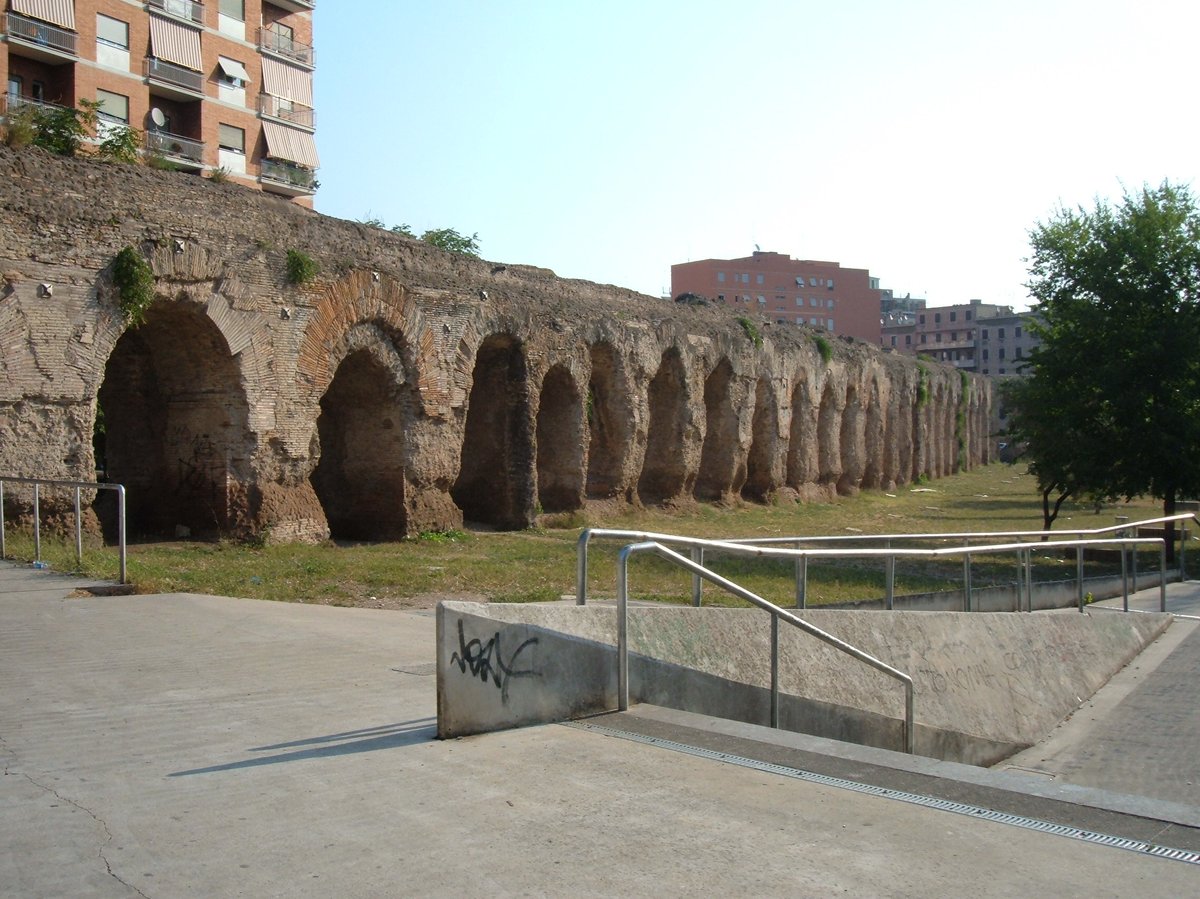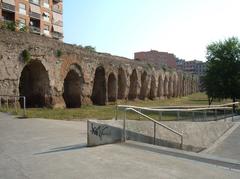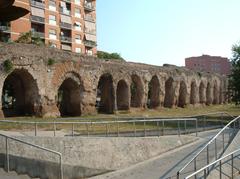
Aqua Alexandrina Visiting Hours, Tickets, and Complete Travel Guide in Rome
Date: 14/06/2025
Introduction to Aqua Alexandrina and Its Historical Significance
Nestled in the eastern outskirts of Rome, the Aqua Alexandrina stands as one of the final monumental achievements of ancient Roman engineering. Commissioned by Emperor Alexander Severus in 226 CE, this aqueduct was primarily built to supply water to the lavish Baths of Alexander in the Campus Martius. Its construction marks the culmination of more than five centuries of Roman aqueduct innovation (Turismo Roma; Roman History). Stretching over 22 kilometers, the Aqua Alexandrina is renowned for its innovative use of brickwork and its towering arches, some exceeding 20 meters in height. Remnants of these majestic structures are still visible today in districts like Centocelle and Tor Pignattara (LA Daily Gazette; The Archaeologist).
Unlike Rome’s more crowded attractions, the Aqua Alexandrina offers a unique, open-access experience where ancient ruins blend harmoniously with modern urban life and tranquil green spaces. This guide provides essential information on visiting hours, ticketing (the outdoor remains are free to access), transportation, and practical tips, as well as a detailed look at the aqueduct’s historical context, engineering marvels, and enduring significance as a symbol of imperial power and civic pride (Rome Tourism; Evendo).
Whether you’d like to stroll beneath the monumental arches at Viale dell’Acquedotto Alessandrino, capture stunning photographs at golden hour, or combine your visit with nearby sites such as the Baths of Caracalla or Parco degli Acquedotti, this guide equips you with everything needed for an enriching and memorable experience (The Wanders; Trip.com).
Table of Contents
- Origins and Construction
- Engineering Features and Route
- Historical Context and Urban Impact
- Decline and Later History
- Visiting the Aqua Alexandrina
- Travel Tips and Seasonal Advice
- Practical Information
- FAQ
- Visual Gallery
- Internal & External Resources
- Summary
- References
Origins and Construction
The Aqua Alexandrina was the last of Rome’s eleven major aqueducts, commissioned by Emperor Alexander Severus in 226 CE to supply water to the newly built Thermae Alexandrinae (Baths of Alexander) in the Campus Martius (Turismo Roma; Roman History; LA Daily Gazette). The aqueduct sourced its water from springs in Pantano dei Grifi (now Pantano Borghese), about 22–24 kilometers east of Rome, near the ancient town of Gabii (Romanaqueducts.info).
Engineering Features and Route
Spanning approximately 22.4 kilometers, the first 6.4 kilometers of the Aqua Alexandrina ran underground to protect the water supply and maintain a gentle gradient. After this, the aqueduct emerged above ground, traversing valleys and ridges on a series of arches and bridges, with some arches in the Centocelle area reaching heights of over 20 meters (Learning History; LA Daily Gazette). The aqueduct’s distinctive use of brick lining instead of the earlier tuff blocks signals advances in Roman construction techniques during the third century CE. As Aqua Alexandrina neared Rome, it descended and became an underground canal, likely entering through Porta Prenestina (modern Porta Maggiore), supplying water to the Esquiline and Quirinal hills and the Campus Martius (LA Daily Gazette).
Historical Context and Urban Impact
Constructed during a period of imperial instability, the Aqua Alexandrina’s completion highlights the enduring importance of public works in Roman policy (Popular Archaeology). At its peak, Rome’s aqueduct network delivered vast quantities of water to sustain the city’s population, support public baths and fountains, and ensure sanitation (Learning History).
Decline and Later History
In 537 CE, during the Ostrogothic siege, Rome’s aqueducts were deliberately cut, leading to the decline of urban life (Popular Archaeology). The Aqua Alexandrina was abandoned for centuries, with only portions remaining above ground, mainly in Rome’s eastern outskirts (LA Daily Gazette). The urban section remains largely undiscovered (LA Daily Gazette).
Visiting the Aqua Alexandrina
Visiting Hours
As the Aqua Alexandrina’s remains are in public parks and along streets, they are generally accessible year-round from dawn to dusk. There are no set opening or closing hours; visiting during daylight is strongly recommended for safety and visibility (Evendo; Trip.com).
Tickets
Visiting the outdoor ruins is free of charge; no tickets are required. Fees may apply if joining guided tours or visiting related museums (Evendo).
Accessibility
The site is accessible by foot, public transport, or bike. Some areas have uneven or grassy terrain, which may pose challenges for visitors with limited mobility. Key sections can be viewed from adjacent sidewalks (Romewise).
Getting There
By Public Transport
- Metro Line A + Bus 105: Metro to ‘Re di Roma’, then bus 105 to Viale dell’Acquedotto Alessandrino (Evendo).
- Bus 81: Direct from Termini Station to Viale dell’Acquedotto Alessandrino.
- Metro Line C: Stops at Mirti or Gardenie for access to Centocelle (Trip.com).
By Car
Set GPS to Viale dell’Acquedotto Alessandrino, 172, 00172 Roma RM. Parking is available on local streets.
Nearby Attractions
- Parco di Centocelle: Urban park ideal for relaxation and picnics.
- Porta Maggiore: Ancient aqueduct junction 3 km away.
- Baths of Caracalla & Parco degli Acquedotti: Easily combined for a comprehensive aqueduct tour (The Wanders).
Guided Tours
Several tour providers offer guided walks focusing on Rome’s aqueducts, including the Aqua Alexandrina. Private guides can provide in-depth historical context (Rome.info).
Travel Tips and Seasonal Advice
- Best Seasons: Visit in spring or autumn for pleasant temperatures and fewer crowds (Mama Loves Rome; Rome Actually).
- Summer: Can be hot; visit early or late in the day.
- Jubilee Years: Ideal alternative during crowded events in central Rome (Dolcevia; Mama Loves Rome).
Practical Information
- Facilities: Limited; restrooms may be found in nearby parks or cafés. Bring water and snacks.
- Safety: Safe during the day; avoid isolated areas after dark.
- Etiquette: Do not climb on or disturb the ruins. Respect local residents and carry out any trash.
FAQ
Q: What are the visiting hours?
A: Open access during daylight hours; no formal opening or closing times.
Q: Is there an entrance fee?
A: No, visiting the ruins is free.
Q: How do I get there by public transport?
A: Metro Line A or C combined with buses 105 or 81, or directly by car.
Q: Is the site wheelchair accessible?
A: Some sections are viewable from sidewalks, but terrain can be uneven.
Q: Can I picnic at the site?
A: Yes, the surrounding parks are ideal for picnics.
Q: Are there restrooms?
A: Facilities are limited; nearby cafés or parks may have restrooms.
Visual Gallery
The well-preserved brick arches of the Aqua Alexandrina near Centocelle.
Map illustrating the Aqua Alexandrina’s route from its springs to Rome.
Internal Links
External Resources
- Turismo Roma - Alexandrian Aqueduct
- Romanaqueducts.info - Aqua Alexandrina
- Trip.com - Aqua Alexandrina
- Romewise - Accessible Rome
- The Archaeologist - Roman Aqueduct Innovations
Summary
Aqua Alexandrina stands as a testament to Rome’s sophisticated engineering and urban planning. Its arches and underground channels once nourished the city’s baths and neighborhoods, symbolizing Rome’s commitment to public welfare and civic grandeur (Popular Archaeology; Roman Empire Times). Today, visitors can explore this remarkable aqueduct for free, enjoying peaceful walks where ancient ruins meet modern life.
Accessible by public transport and open throughout the year, Aqua Alexandrina is an ideal destination for those seeking to discover Rome’s lesser-known treasures. Prepare with comfortable shoes, sun protection, and a camera to fully appreciate the site’s beauty and historical context. For the latest tips, download the Audiala app, explore related posts, and follow local tourism resources (Turismo Roma; Evendo).
References
- Turismo Roma
- Roman History
- LA Daily Gazette
- The Archaeologist
- Roman Empire Times
- Evendo
- The Wanders
- Trip.com
- Rome.info
- Romewise
- Popular Archaeology
- Mama Loves Rome
- Rome Actually
- Learning History
- Romanaqueducts.info
- Dolcevia



















































































































































































































































